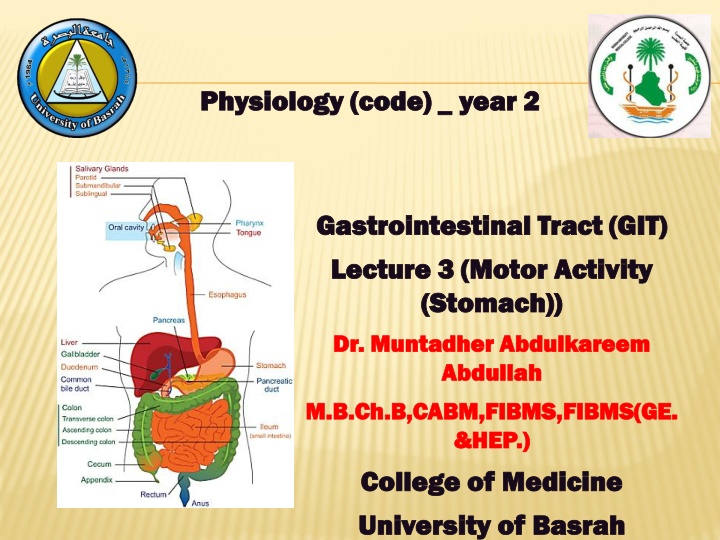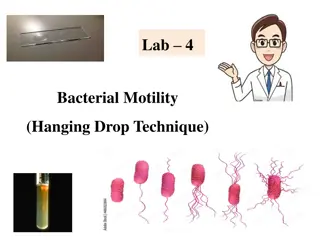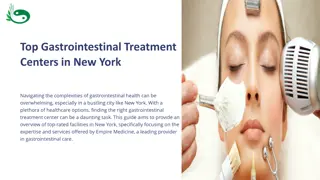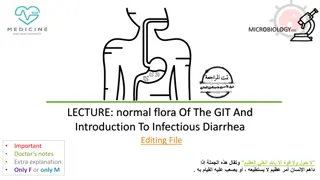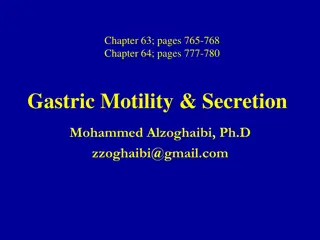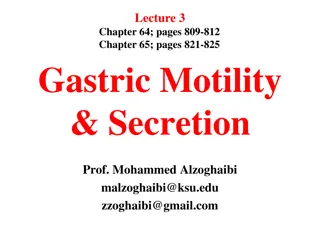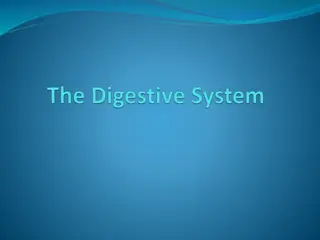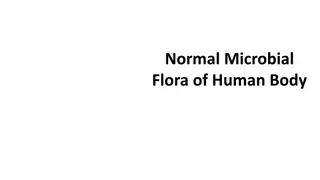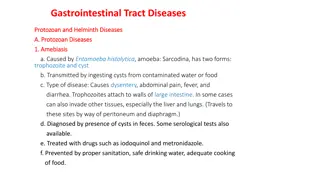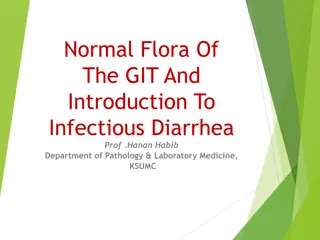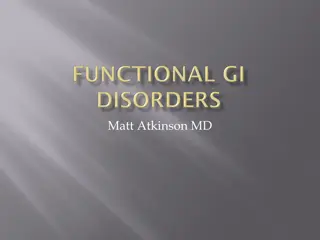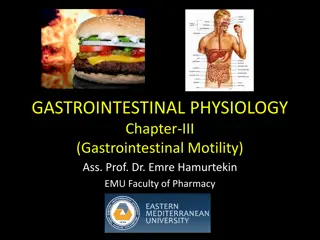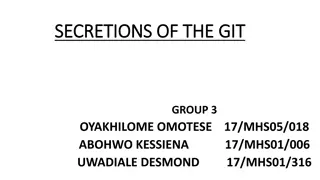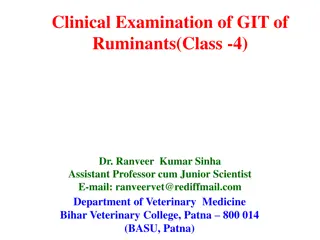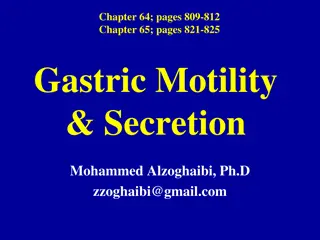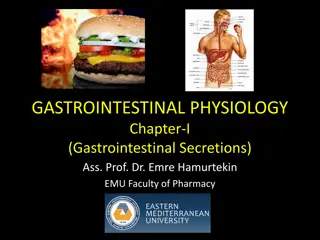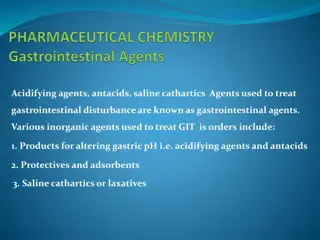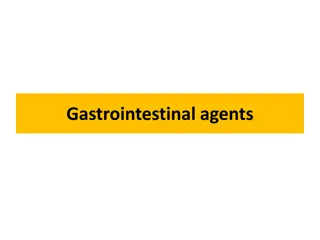Gastric Motility and Function in the Gastrointestinal Tract
The stomach plays a crucial role in digestion, from storage and mixing of food to slow emptying of chyme into the duodenum. Gastric motility involves peristalsis and retropulsion, essential for propelling food towards the pylorus. Dr. Muntadher Abdulkareem Abdullah provides valuable insights into the control and functions of the stomach, including motor activity and functional disorders. Explore the main functions of the stomach and the intricate processes involved in gastric motility at the Physiology Department of the College of Medicine, University of Basrah.
Uploaded on Sep 23, 2024 | 1 Views
Download Presentation

Please find below an Image/Link to download the presentation.
The content on the website is provided AS IS for your information and personal use only. It may not be sold, licensed, or shared on other websites without obtaining consent from the author.If you encounter any issues during the download, it is possible that the publisher has removed the file from their server.
You are allowed to download the files provided on this website for personal or commercial use, subject to the condition that they are used lawfully. All files are the property of their respective owners.
The content on the website is provided AS IS for your information and personal use only. It may not be sold, licensed, or shared on other websites without obtaining consent from the author.
E N D
Presentation Transcript
Physiology ( Physiology (code) _ code) _ year year 2 2 Gastrointestinal Tract (GIT) Gastrointestinal Tract (GIT) Lecture Lecture 3 3 (Motor Activity (Motor Activity (Stomach)) (Stomach)) Dr. Muntadher Abdulkareem Dr. Muntadher Abdulkareem Abdullah Abdullah M.B.Ch.B,CABM,FIBMS,FIBMS(GE. M.B.Ch.B,CABM,FIBMS,FIBMS(GE. &HEP.) &HEP.) College of Medicine College of Medicine University of University of Basrah Basrah
Objectives: 1.Describe stomach and the control of that functions. the motor functions of the 2.Describe the functional disorders. University of Basrah-College of Medicine-Physiology Department 1
Stomach Stomach The stomach can be divided into: the fundus, body and the antrum. University of Basrah-College of Medicine-Physiology Department 2
main function of the stomach are: 1. Storage of food until digested. When food enters the stomach a vagel reflex greatly reduces the tone in the muscular wall of the body of the stomach, so that the wall can bulge progressively outward accommodating greater and greater quantities of food up to a limit of about (1 liter), this process is called receptive relaxation. University of Basrah-College of Medicine-Physiology Department 3
2. Mixing of food with gastric secretion until it forms a semi fluid mixture called chyme. When the stomach is filled, weak peristaltic constrictor waves called mixing waves, move toward the antrum along the stomach wall approximately once every 20 seconds. As the constrictor waves progress from the body of the stomach into the antrum, they become more intense, providing powerful peristaltic constrictor rings that force the antral contents under high pressure toward the pylorus. 3. Slow emptying of chyme to the duodenum at a rate suitable for proper digestion and absorption by the small intestine. University of Basrah-College of Medicine-Physiology Department 4
Gastric motility: a. Peristalsis: peristaltic contractions are initiated near the fundal-body border and proceed caudally, producing a peristaltic waves that propels the food towards the pylorus, which occur every 20 sec. and are produced by periodic changes in membrane potential, called slow waves. b. Retropulsion (mixing): it is the back and forth movement of the chyme caused by the forceful propulsion of food against the closed pyloric sphincter. University of Basrah-College of Medicine-Physiology Department 5
All food enters the stomach passes to the duodenum and this is regulated by the stomach itself. Normal diet takes 3 hours to be emptied to the duodenum. Fasting for 12 hours increases antral peristalsis hunger contraction accompanied with pain. This is considered as the pacemaker of the stomach. University of Basrah-College of Medicine-Physiology Department 6
Factors affecting gastric emptying: 1.Gastric factors: these factors arises from stomach and includes: a. Nervous factors: stimulated by food in the stomach increase motility and secretion through nervous system increase stomach emptying due to increased antral peristalsis (enteric nervous system and vagus nerve) b. Humoral factors: stimulated by food in stomach increase in gastrin secretion increase in motility, secretion, and antral peristalsis. enteric University of Basrah-College of Medicine-Physiology Department 7
2. Duodenal factors: arises from duodenum and mediated by entero-gastric reflex. a. Nervous factors: entero-gastric reflex arising from duodenum will go to the stomach to inhibit the antral peristalsis through myenteric nervous system and sympathetic system. The main stimuli for entero-gastric reflex are: 1. Over distention of duodenum. 2. Irritation of duodenum. 3. Hyper acidic chyme in duodenum. University of Basrah-College of Medicine-Physiology Department 8
. The pH of chyme (4.5), the duodenal mucosa used to be alkaline medium so when acidic chyme comes to the duodenum it will be neutralized by pancreatic juice and biliary secretion but when the chyme is too acidic it will causes the irritation of duodenal mucosa enterogastric reflex inhibit stomach emptying. 4. Hyperosmolar chyme: osmolarity in the lumen of duodenum is 300 mosm/L. When the chyme entering duodenum is hyperosmolar (>300mos/L) stimulate the enterogastric reflex then water will get out from mucosal cells of duodenum to the lumen. University of Basrah-College of Medicine-Physiology Department 9
b. Humoral factors: fat or acid or both in duodenum will inhibit the antral peristalsis due to release of hormones. Fat stimulates CCK-PZ secretion, acid stimulate release of secretin, both fat and acid in chyme stimulate the release of gastric inhibitory peptide. University of Basrah-College of Medicine-Physiology Department 10
Recap: The stomach can be divided into: the fundus, body and the antrum. The gastric motility achieved by Peristalsis and Retropulsion (mixing) movements. All food enters the stomach passes to the duodenum and this is regulated by the stomach itself. Normal diet takes 3 hours to be emptied to the duodenum. Questions: Write T or F against each of following statements: 1. Receptive relaxation of the stomach under the control of facial nerve. 2. Normal diet takes 12hours to be emptied to the duodenum. University of Basrah-College of Medicine-Physiology Department 11
